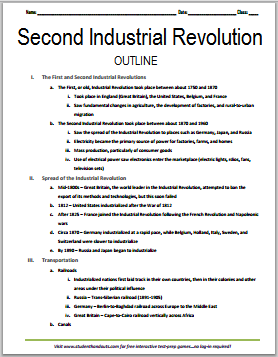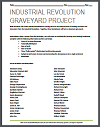Outline of the Second Industrial Revolution |
| This free printable outline covers the second phase (started around 1870) of the Industrial Revolution. It is perfect for students and teachers of World History, Global Studies, and European History (both AP and general education courses). Scroll down for a printable version of this outline (.pdf format). |

I. The First and Second Industrial Revolutions a. The First, or old, Industrial Revolution took place between about 1750 and 1870 i. Took place in England (Great Britain), the United States, Belgium, and France ii. Saw fundamental changes in agriculture, the development of factories, and rural-to-urban migration b. The Second Industrial Revolution took place between about 1870 and 1960 i. Saw the spread of the Industrial Revolution to places such as Germany, Japan, and Russia ii. Electricity became the primary source of power for factories, farms, and homes iii. Mass production, particularly of consumer goods iv. Use of electrical power saw electronics enter the marketplace (electric lights, radios, fans, television sets) II. Spread of the Industrial Revolution a. Mid-1800s – Great Britain, the world leader in the Industrial Revolution, attempted to ban the export of its methods and technologies, but this soon failed b. 1812 – United States industrialized after the War of 1812 c. After 1825 – France joined the Industrial Revolution following the French Revolution and Napoleonic wars d. Circa 1870 – Germany industrialized at a rapid pace, while Belgium, Holland, Italy, Sweden, and Switzerland were slower to industrialize e. By 1890 – Russia and Japan began to industrialize III. Transportation a. Railroads i. Industrialized nations first laid track in their own countries, then in their colonies and other areas under their political influence ii. Russia – Trans-Siberian railroad (1891-1905) iii. Germany – Berlin-to-Baghdad railroad across Europe to the Middle East iv. Great Britain – Cape-to-Cairo railroad vertically across Africa b. Canals i. Suez Canal (1869) – provided access to the Indian Ocean from the Mediterranean Sea without the need to sail around Africa ii. Kiel Canal (1896) – North Sea connected to the Baltic Sea iii. Panama Canal (1914) – provided access from one side of the Americas to the other without the need to sail around the tip of South America c. Automobiles i. Charles Goodyear – vulcanized rubber, 1839 ii. Gottlieb Daimler – gasoline engine, 1885 iii. Henry Ford – assembly line, 1908-1915 d. Airplanes i. Orville and Wilbur Wright – airplane, 1903 ii. Charles Lindbergh – first non-stop flight across the Atlantic, 1927 iii. 20th century – growth of commercial aviation IV. Review Questions a. Compare and contrast the First and Second Industrial Revolutions. b. When did the United States begin to industrialize? c. Explain how trains and canals aided transportation, citing at least one example for each. d. What contributions did Charles Goodyear, Gottlieb Daimler, and Henry Ford make to automobile production? |
| Click here to print. |
 |











